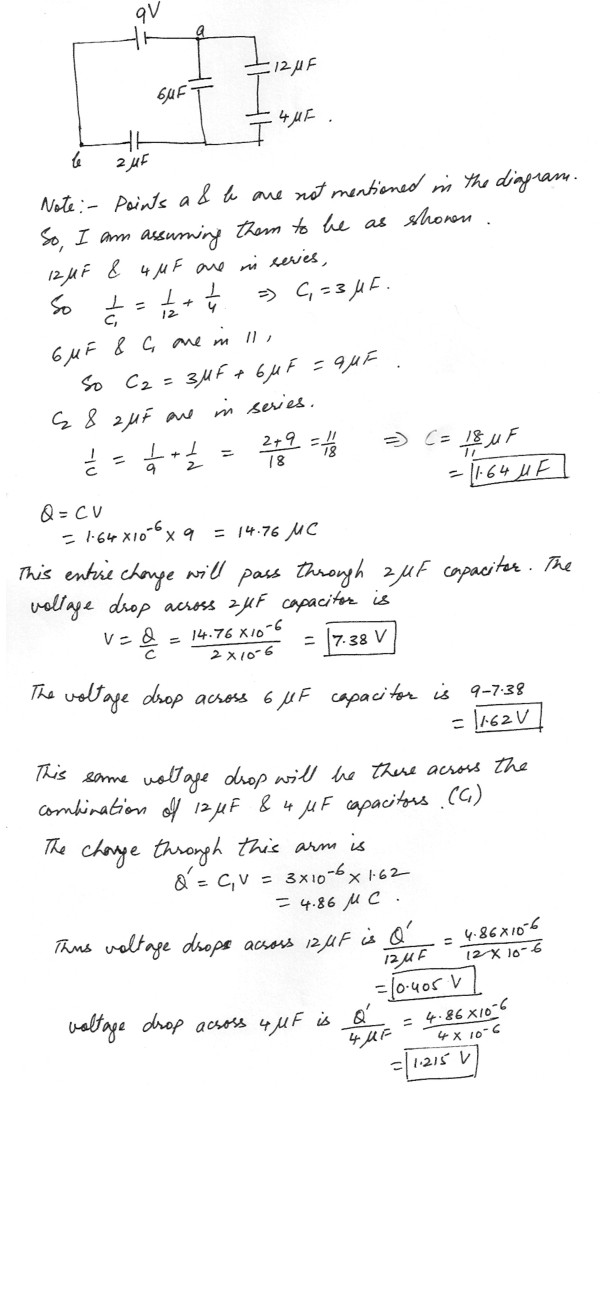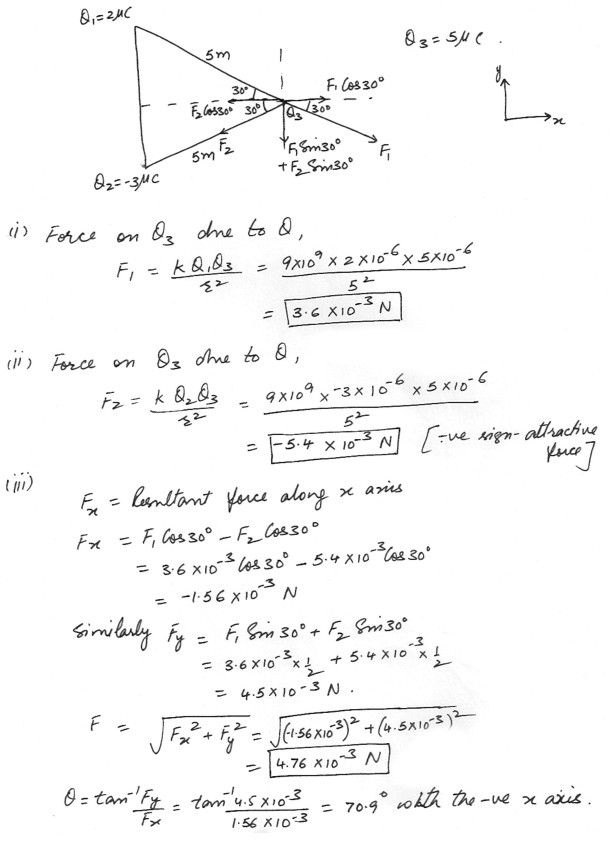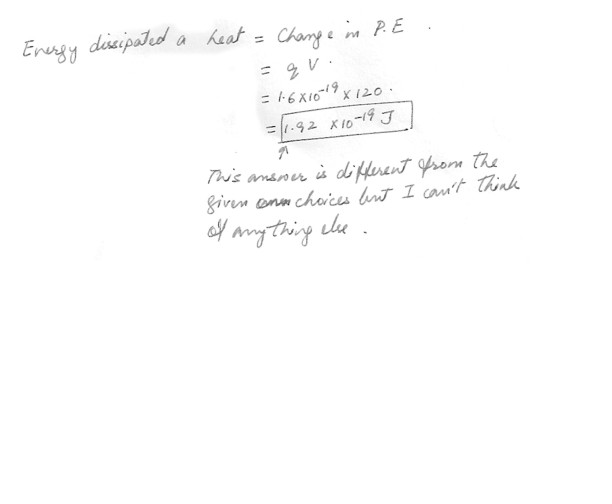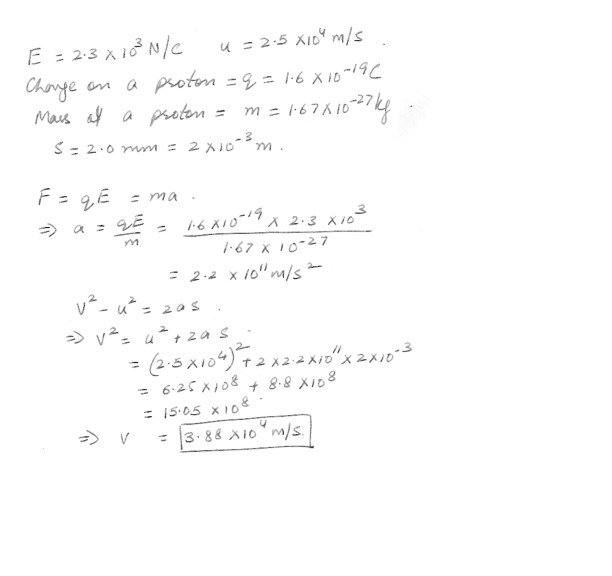Physics Electrostatics Level: High School
As per the figure at ‘click here’ find the charge on each of the capacitors .
Physics Electrostatics Level: High School
In the diagram as shown in the figure at ‘click here’a) find the equivalent capacitance between points a and b
b) find the voltage drop across each capacitor

Physics Electrostatics Level: High School
A proton is released from rest in a uniform electric field of 100,000 volts/m in the positive x direction, as shown in the figure at ‘click here’a) Which way will the proton move ?
b) If the proton moves .05 meter what is the change in electric potential ?
c) What is the force on the proton ?
d) What is the change in electric potential energy ?
Replace the proton with an electron and repeat a, b , c and d .
Physics Electrostatics Level: High School
Two charges are positioned as shown in the figure at “click here”a) Find the Electric field strength E at point A
b) Find the electric potential V at point A
c) Find the force F on an electron at point A
d) Find the potential energy of the pair of charges

Physics Electrostatics Level: High School
Three charges are positioned as shown in the figure at ‘click here’a) What is the force on Q3 due to Q1
b) What is the force on Q3 due to Q2
c) What is the resultant force on Q3

Physics Electrostatics Level: High School
A parallel plate capacitor has a potential difference between its plates of 1.2 V and a plate separation distance of 2.0 mm. What is the magnitude of the electric field if a material that has a dielectric constant of 3.3 is inserted between the plates ?
Physics Electrostatics Level: High School
A parallel-plate capacitor with air dielectric has a plate area of 75 cm^2 . If the capacitor is fully charged by a 300-V source and can hold a charge of 7.5 x 10^9 C , What is the distance between the plates ?a) 2.7
b) 3.1
c) 5.3
d) 6.9

Physics Electrostatics Level: High School
The normal hydrogen atom consist of a proton nucleus and an orbital electron . Assume that the electron orbit is circular and that the constant distance between the proton and electron is 5.3 x 10^-11 m . What is the orbital speed of the orbiting electron ? (Hint: The centripetal force that keeps these electron in its orbit must equal the force of attraction)a) 1.4 x 10^6 m/sec
b) 1.90 x 10^6 m/sec
c) 2.19 x 10^6 m/sec
d) 3.11 x 10^6 m/sec
F = mv^2/r
Physics Electrostatics Level: High School
The normal hydrogen atom consist of a proton nucleus and an orbital electron . Assume that the electron orbit is circular and that the constant distance between the proton and electron is 5.3 x 110^-11 m . What is the force of attraction between the two fundamental particles ?a) 1.77 x 10^-8 N
b) 3.35 x 10^-8 N
c) 6.18 x 10^-8 N
d) 8.20 x 10^-8 N

Physics Electrostatics Level: High School
The parallel cathode and plate of a vacuum tube are 2 cm apart and have 120 V between them . What is the energy dissipated as heat on the plate ?a) 1.89 x 10^-17 J
b) 3.21 x 10^-17 J
c)1.11 x 10^-16 J
d) 4.00 x 10^-16 J

Physics Electrostatics Level: High School
A positive charge of +Q1 is located 3.00 m to the left of a negative charge –Q2 . The charges have different magnitudes . On the line through the charges , the net electric field is 0 at a spot 1.00 m to the right of the negative charge . On this line there are also two spots where the potential is 0 . Locate these two spots relative to the negative charge .
Physics Electrostatics Level: High School
A square is .50 meters on a side . Four identical charges (5.0 mC each ) are brought from infinity and placed on the square , one to a corner . Find the electric potential energy of the group .
Physics Electrostatics Level: High School
An electron and a proton starting from rest , are accelerated through an electric potential difference of the same magnitude . In the process , the electron acquires a speed Ve while the proton acquires a speed Vp . Find the ratio Ve/Vp .
Physics Electrostatics Level: High School
A uniform electric field has a magnitude of 2.3 x 103 N/C . In a vaccum a proton begins with a speed of 2.5 x 104 m/s and moves in the direction of this field . Find the speed of the proton after it has moved a distance of 2.0 mm .
Physics Electrostatics Level: High School
Two spherical shell have a common center . A negative 1.6 x 10-6 C charge is spread uniformly over the inner shell , which has a radius of .050 m . A positive 5.1 x 10-6 C charge is spread uniformly over the outer shell , which has a radius of , 15 m Find the magnitude and direction of the electric field at a distance (measured from the common center) ofa) .20 m
b) .10 m
c) .025 m

